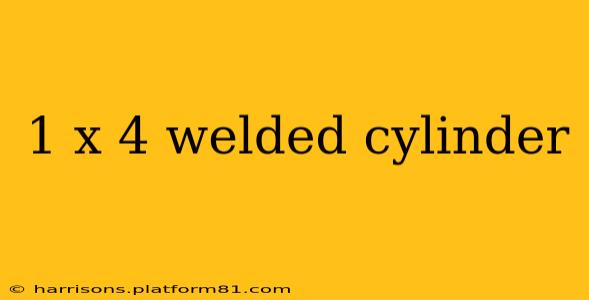A 1 x 4 welded cylinder refers to a cylindrical structure with a diameter of 1 unit and a length of 4 units. This seemingly simple description encompasses a wide range of applications and manufacturing considerations, depending heavily on the intended use and the material employed. This guide will explore the various facets of 1 x 4 welded cylinders, addressing common questions and providing in-depth information.
What are the typical applications of a 1 x 4 welded cylinder?
The applications of a 1 x 4 welded cylinder are remarkably diverse, ranging from structural components in engineering to specialized parts in machinery. The specific use depends heavily on the material the cylinder is made from (e.g., steel, aluminum, or other alloys). Common applications include:
- Structural Support: In various frameworks and support structures, these cylinders can provide strength and stability.
- Mechanical Components: They can serve as housings for mechanisms, shafts, or other moving parts.
- Fluid Containment: Depending on the material and welding integrity, they could be used to contain liquids or gases. However, this application would require rigorous pressure testing and material selection.
- Custom Fabrication: Many specialized industries require uniquely shaped components, and a 1 x 4 welded cylinder might be a fundamental building block for a larger assembly.
What materials are typically used to create 1 x 4 welded cylinders?
The choice of material dictates the cylinder's properties and suitability for specific applications. Common materials include:
- Steel: Offers high strength and durability, making it suitable for structural applications and high-stress environments. Different grades of steel offer varying levels of strength and corrosion resistance.
- Aluminum: Lighter than steel and offering good corrosion resistance, aluminum is preferred when weight is a critical factor. However, it's generally less strong than steel.
- Stainless Steel: Provides excellent corrosion resistance, making it ideal for applications involving harsh chemicals or environments with high humidity.
The selection of the most appropriate material requires careful consideration of factors such as strength requirements, weight limitations, corrosion resistance needs, and cost.
What welding techniques are typically used for 1 x 4 welded cylinders?
The welding process is critical to ensuring the structural integrity of the cylinder. Several techniques are commonly employed, each with its strengths and weaknesses:
- Gas Metal Arc Welding (GMAW): Also known as MIG welding, this is a versatile and efficient process suitable for various materials.
- Gas Tungsten Arc Welding (GTAW): Often referred to as TIG welding, this method produces high-quality welds with excellent control, particularly beneficial for thinner materials.
- Shielded Metal Arc Welding (SMAW): Also known as stick welding, this technique is robust and portable but generally produces welds with a slightly rougher finish compared to GMAW or GTAW.
The optimal welding technique will depend on factors such as material thickness, material type, and desired weld quality. Often, specialized welders with extensive experience are required to ensure seamless and strong welds, especially when dealing with high-pressure applications.
How is the precision of a 1 x 4 welded cylinder ensured?
Achieving precise dimensions (1 x 4) requires careful attention to detail throughout the manufacturing process. This includes:
- Precise Material Cutting: Accurate cutting of the material to the required dimensions is the foundation of a precise cylinder. Laser cutting or waterjet cutting often provides the best accuracy.
- Proper Welding Techniques: The welding process itself should minimize distortion and ensure a consistent weld bead.
- Post-Weld Machining: In some cases, post-weld machining might be necessary to achieve the exact desired dimensions and surface finish.
- Quality Control: Rigorous quality control measures, including dimensional inspection and non-destructive testing (NDT), are crucial for verifying the cylinder's dimensional accuracy and structural integrity.
What are the common challenges in manufacturing 1 x 4 welded cylinders?
Manufacturing 1 x 4 welded cylinders presents several potential challenges:
- Weld Distortion: The heat generated during welding can cause the material to warp or distort, potentially affecting the final dimensions.
- Weld Defects: Incomplete penetration, porosity, or other weld defects can compromise the structural integrity of the cylinder.
- Material Selection: Choosing the right material for the intended application can be complex, requiring consideration of numerous factors.
- Cost-Effectiveness: Balancing the need for precision and quality with cost-effective manufacturing processes is crucial.
Careful planning, skilled craftsmanship, and rigorous quality control are essential to overcome these challenges and produce high-quality 1 x 4 welded cylinders. The manufacturing process must be tailored to meet the specific demands of the intended application.
